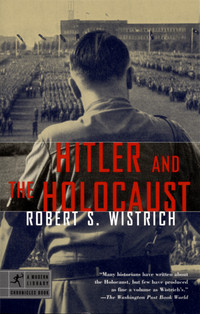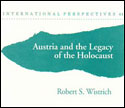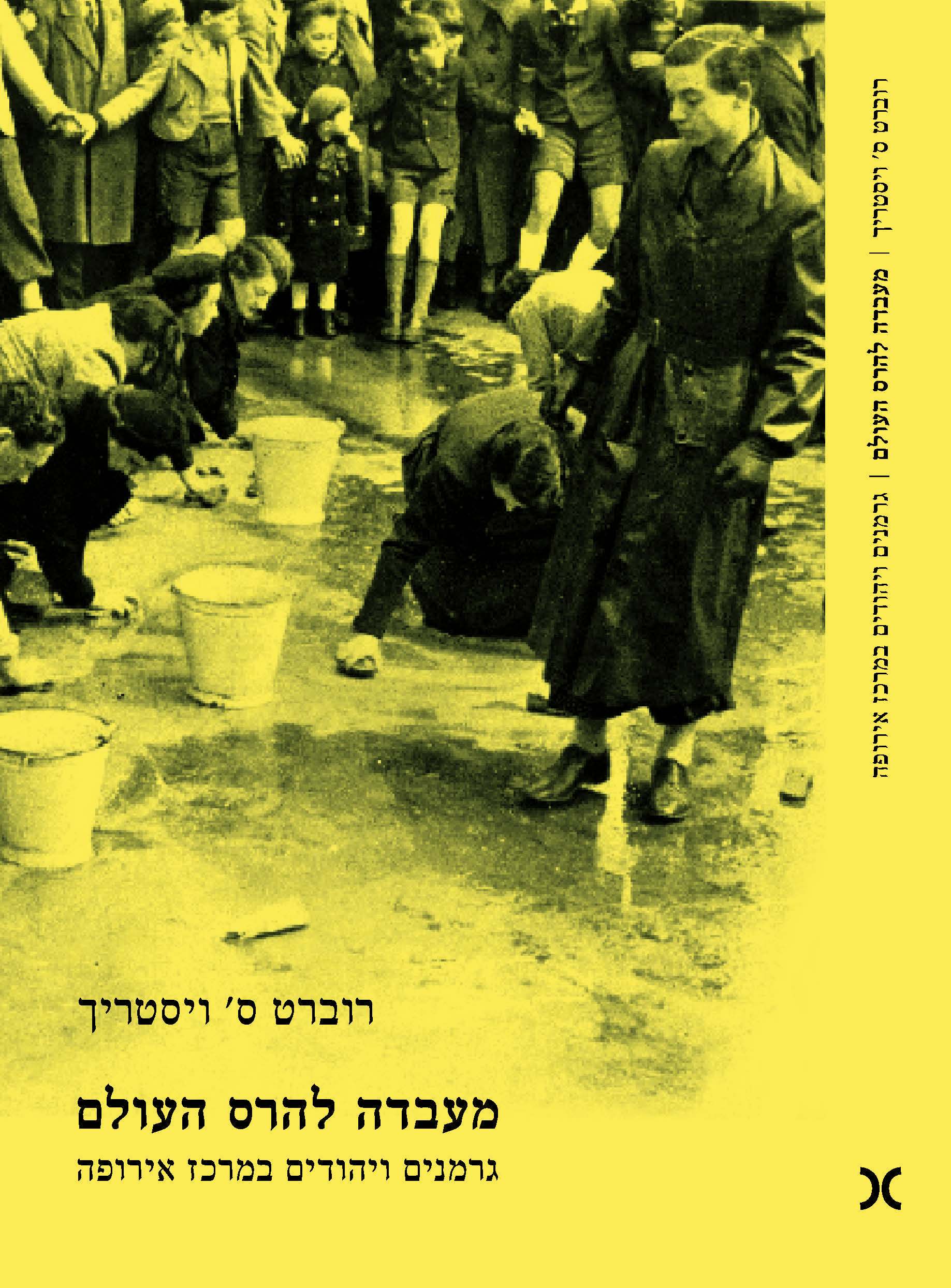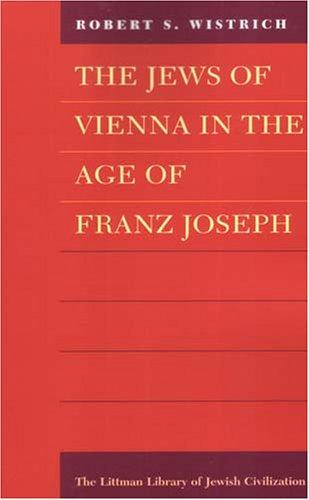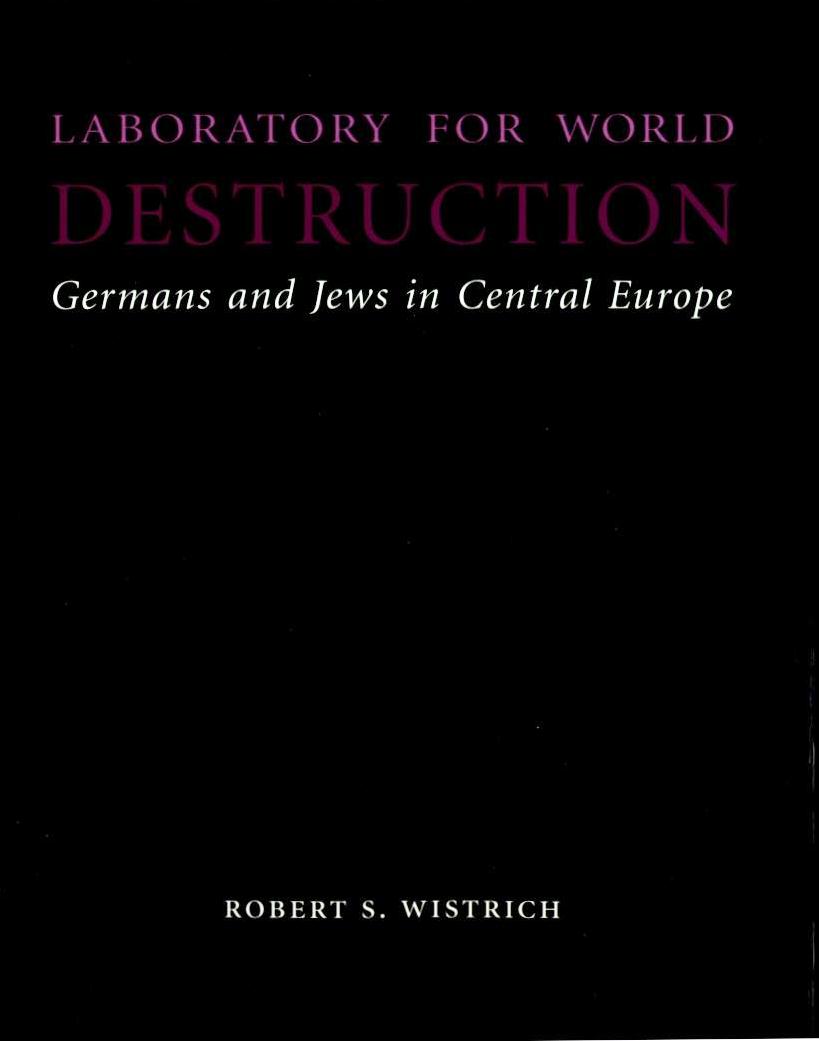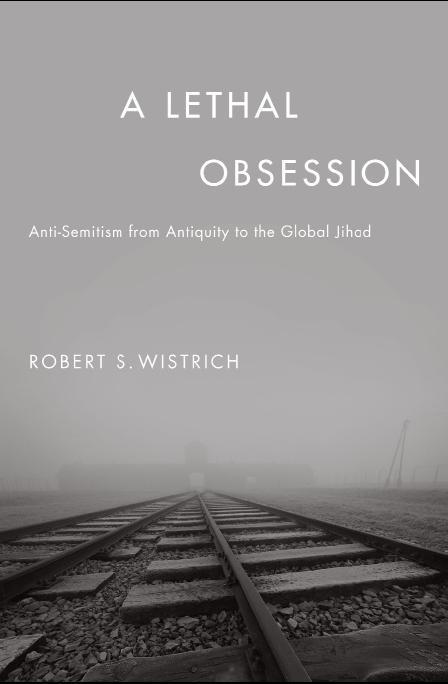The emergence of the state of Israel has fundamentally changed the conditions of Jewish existence. The issues now facing Jews everywhere are totally different to those that confronted them only fifty years ago.
This book provides the only thoroughly worldwide modern history of the Jews of the Diaspora. Robert Wistrich has drawn together an outstanding collection of authors from the United States, Europe and Israel in order to analyse the immense changes that have taken place since 1945 in a comprehensive, yet original, manner.
Cultural, religious, domestic, political, economic and occupational transformations in Jewry are addressed in up-to-date studies.
Terms of Survival reframes the nature of the debate by highlighting continuity and change in the position of the Jews throughout the world.
| Book Abstracts |
| Books |
Here you can find Prof. Robert Wistrich's books, including book abstracts, covers and links for purchasing them.
|
Abstracts |
Covers |
|
Revolutionary Jews from Marx to Trotsky For many Jews in the 19th-20th centuries, socialism and communism were seen as paths to their social and political emancipation as human beings, a way to flee from social ostracism. Examines the lives and works of ten Jews who were socialist leaders, from Marx to Trotsky. Regarding antisemitism, it was generally seen as an evil aspect of capitalism, a special case of bourgeois racism. Assimilation of the Jews was a prerequisite of the socialist revolution. Jewish socialists adopted not only the universalism of their non-Jewish revolutionary contemporaries, but also their anti-Jewish stereotypes. Jewish self-hatred was common amongst them and affected their socialist views. In their antisemitism, Marx and Lassalle surpassed some of their non-Jewish fellow socialists. The rise of political antisemitism in the 20th century, the Dreyfus Affair, brutal pogroms, and Nazism made some of the Jewish socialists (e.g. Bernstein, Lazare) revise their views and speak out against antisemitism, but did not affect others (e.g. Luxemburg, Adler). |
Purchase the Book! |
|
"Trotsky: Fate of a Revolutionary" |
 Purchase the Book! |
|
"Theories of Fascism" |
|
|
"Socialism and the Jews: The Dilemmas of Assimilation in Germany and Austria-Hungary" Analyzes the role of the "Jewish question" in the politics of the German and Austrian Social Democratic parties before 1914. Socialism was not immune to antisemitism, and early socialists were ambivalent regarding the issue of Jewish emancipation. German Social Democracy parted ways with antisemitism only in the 1880s. At the same time, it tended to downplay antisemitism as a transitory phenomenon doomed to disappear. In the 1890s, on the wave of the "völkisch" movement, it even noted a revolutionary, anti-capitalist potential for antisemitism. While opposing antisemitism, the party did not want to appear as philosemitic. In Austria, populist antisemitism (e.g. that of Schönerer and Lueger) was more influential. It was only after Lueger’s victory in Vienna that the Social Democrats altered their policy and attacked the Christian Socialists as a reactionary movement; to this end, they also used antisemitic arguments. As in Germany, Austrian Social Democrats tried to remain "neutral" toward antisemitism. In both Germany and Austria, the Social Democrats consistently denied that Jews constitute a nation and opposed all Jewish national movements. |
 Purchase the Book! |
|
"The Left Against Zion: Communism, Israel Ciolkosz, Adam. ’Anti Zionism’ in Polish Communist Party Politics [An earlier version appeared in the "Wiener Library Bulletin" 22, 3 (1968).] (137-152); |
 Purchase the Book! |
|
"Who’s Who in Nazi Germany"
Who's Who in Nazi Germany is a fascinating and indispensable source of reference for everyone interested in this pivotal period in twentieth century history. |
 Purchase the Book! |
|
"Hitler’s Apocalypse: Jews and the Nazi Legacy"
A study of Hitler’s antisemitic, apocalyptic worldview, how it was translated into Nazi ideology and the implementation of the destruction of European Jewry, and how it has been adopted and adapted in the postwar period by the Soviet Union and Arab and Muslim countries. Chs. 1-8 (pp. 12-173) deal with Hitler and Nazism. States that Hitler always spoke of the destruction of Jewry in tones of apocalyptic fervor. It was the fusion of a modern, totalitarian political praxis with a gnostic-racist Manichean ideology of war against the forces of Darkness that provided the radical novelty in Hitler’s movement. He used the tsarist Russian idea of an international Jewish conspiracy as his inspiration for a radical restructuring of the modern political world. The Soviet, Arab and Islamic antisemitism described in chs. 9-12 (pp. 174-255) are part of a multi-layered continuum of blood-curdling rhetoric which postulates the existence of an international, shadowy occult conspiracy with its Jewish political center in Israel. This crusade goes today under the name of "anti-Zionism." |
 Purchase the Book! |
|
"The Jews of Vienna in the Age of Franz Joseph"
(1st Edition)
Analyzes the communal organization, political affiliations, and cultural contributions of Vienna’s Jews from 1848 to World War I. After 1848, Jewish emancipation became an issue in party politics. Jews identified with the Austrian Liberal Party, with the Emperor and Germanism, in all of which they saw safeguards of Jewish emancipation. Analyzes the antisemitism of Schönerer’s Pan-German Party, which found many adherents at the University of Vienna, and of Lueger’s Christian Social Party. Describes the cautious reactions of Jewish officials, who supported the Liberal Party even in defeat and in the face of that party’s desertion of the Jewish cause; the more nationalist faction led by Rabbi Joseph Samuel Bloch, a member of the Austrian parliament from 1884-95 and a militant fighter against antisemitism; and the Austrian Israelite Union set up in 1886 to encourage pride in Jewish identity and combat antisemitism. Surveys the role of antisemitism in the rise of Zionism. Suggests that the surge of antisemitism in Vienna, rather than the Dreyfus case, was responsible for Herzl’s concern with the "Jewish question". Analyzes the Jewish self-hatred of Karl Kraus and Otto Weininger, and the role of Jewish identity and antisemitism in the life and work of Freud, Schnitzler, and other Austrian Jewish writers. |
 Purchase the Book! |
|
"Between Redemption and Perdition.
Antisemitismand Jewish Identity" A collection of essays and lectures, most of them published previously and revised here. A number of essays deal with the emergence of the "Jewish question" in 19th-century Europe, the rise of modern antisemitism in 20th-century Central Europe, Nazi racist ideology, and cultural and political aspects of antisemitism and anti-Zionism in the postwar world. Partial contents: Karl Marx and the Enlightenment (9-16); Antisemitism as a Radical Ideology (31-42); Karl Lueger in Historical Perspective (43-54); Hitler and National Socialism: The Austrian Connection (55-67); The Strange Case of Bruno Kreisky (107-120); The Fassbinder Controversy [Appeared in the "Jerusalem Quarterly" 50 (1989).] (121-129); French Socialism and the Dreyfus Affair (133-149); Zionism as a Jewish Revolution (181-191); Antisemitism and the Origins of Zionism (195-205); The Myth of the Jew in Contemporary France (206-213); Global Anti-Zionism in the 1980s (214-224); The New War against the Jews (225-235); Under the Sign of "Glasnost" (236-241); The Politics of Perdition (242-245); Soundings in the Gulf (246-253); The Fundamentalist Challenge (254-264). |
 Purchase the Book! |
|
"Anti-Zionism and Antisemitism in the Contemporary World"
Part I: "Communist and Left Anti-Zionism": |
 Purchase the Book! |
|
"Antisemitism: The Longest Hatred"
A history of antisemitism, written to accompany the Thames Television series "The Longest Hatred" (1991). Surveys the evolution in antiquity from pagan hostility toward Jews to Christian anti-Judaism, and the latter’s overwhelming influence on modern antisemitism. Mentions the antisemitic leanings of 19th-century socialist ideologues and of Karl Marx. Traces the evolution of Austrian and German antisemitism and their culmination in Hitler’s racist ideology and the legitimation of the Final Solution. Examines postwar forms of antisemitism in both countries, focusing on Fassbinder’s play and the Waldheim affair. Reviews past and present-day antisemitism in Britain, America, France, and Eastern Europe. Remarks on the extent of anti-Zionist propaganda in the Soviet Union and ideological antisemitic tendencies among former Soviet dissidents (e.g. I. Shafarevich). Surveys the status of the Jews in Islamic lands, blood libels in those countries, widespread anti-Jewish stereotypes, the "world Jewish conspiracy" accusation, and Islamic fundamentalist antisemitism. |
 Purchase the Book! |
|
"Austrians and the Jews in the Twentieth Century:
From Franz Joseph to Waldheim" Kieval, Hillel Joseph. Jews, Czechs and Germans in Bohemia before 1914 (19-37); |
 Purchase the Book! |
|
"Weekend in Munich: Art, Propoganda and Terror
in the Third Reich" Discusses Nazi ideology and the centrality of the arts in Hitler’s worldview and as an instrument of propaganda. Analyzes the Nazi concept of "degenerate" art, which was equated with Jewish-influenced art, even though most of the artists condemned by the Nazis were not, in fact, Jewish. Describes the third annual Day of German Art celebrated in Munich on 14-16 July 1939 and attended by Hitler and most of the leading Nazis. This festival was filmed in technicolor by a group of amateurs. In conjunction with the screening on British television in 1993 of a documentary based on this film ("Good Morning, Mr. Hitler"), the directors interviewed Munich citizens who had taken part in the Festival in their youth and who recalled their enjoyment. Most of them denied having known anything of the Holocaust. Charlotte Knobloch, a Jewish survivor, recalls a very different youth, spent in constant fear. The last chapter points to the revival of neo-Nazism, Skinhead violence against foreigners and Jews, and Holocaust denial in reunified Germany and elsewhere in the world. |
 Purchase the Book! |
|
"Fascist Antisemitism and the Italian Jews"
A collection of papers delivered at a symposium held in Jerusalem on "Fifty Years after the Racial Laws in Italy." Contents: |
 Purchase the Book! |
|
"Terms of Survival: The Jewish World Since 1945"
|
 Purchase the Book! |
|
"The Shaping of Israeli Identity: Myth, Memory
and Trauma"
|
|
"מיתוס וזיכרון : גלגוליה של התודעה הישראלית"ציר הזיכרון הישראלי נמתח מהמהפכה הציונית ועד לוויכוח על הפוסט-ציונות. האם הישראלים מעצבים את המיתוסים שלהם בכל דור ודור – ובוחנים אותם באופן ביקורתי – או שמא המיתוסים מתנים את דפוסי מחשבתם ופועלם? כיצד מכונן המיתוס את הזיכרון הקולקטיווי של הישראלים? מהו מקומו של זיכרון מתהווה זה בפעולה הפוליטית, במחשבה החברתית וביצירה התרבותית של הישראלים? האם עוד אפשר לדבר על הישראלים בה"א הידיעה? לפנינו מחקר רב-תחומי ראשון מסוגו, שתכליתו בירור נוכחותם של המיתוסים במחשבה היהודית, באידיאולוגיה הציונית ובחברה הישראלית. שישה-עשר המאמרים המוצגים בו חושפים וממפים את "הסדר המיתי" ביהדות, בציונות ובישראליות. המחברים רואים במיתוס אמת פרספקטיווית, אופן אחר של פרשנות, המבעבע מתחת לפני השטח כזרם תת-קרקעי. המחקר דן בגרשם שלום ובבאבא סאלי, בטרומפלדור ובאמיל גרינצוויג, ברבי מלובביץ' ובפרידריך ניטשה, בהרצל ובבן-גוריון, במצדה ובאושוויץ, בתל-חי ובנתיבות, בעקידת יצחק ובאנתיפאדה, במשיחיות ובפוסט-ציונות. |
 Purchase the Book! |
|
"Wandlungen und Brüche. Von Herzls “Welt” zur “Illustrierten Neuen Welt,” 1897-1997"
Significant portions of the following articles deal with antisemitism in Austria: Montel, Angelika. Herzls Maitresse: Zur Gründung der "Welt" (19-66);
|
|
|
"Die Juden Wiens im Zeitalter "Ein künftiges Standardwerk ... stilistisch meisterhaft", so Peter Pulzer in der London Review of Books beim Erscheinen der englischen Originalausgabe dieses Werkes, das nunmehr in Übersetzung vorliegt. Robert Wistrich untersucht in diesem vielbeachteten Buch das "Goldene Zeitalter" des Wiener Judentums während der Regierungszeit Kaiser Franz Josephs. Basierend auf umfangreichem, akribischem Quellenstudium bietet die Darstellung eine Vielzahl neuer Erkenntnisse über die Fakten, die diese Blütezeit ermöglichten, aber ebenso über die ideologischen Konflikte, die den Beginn des 20. Jahrhunderts kennzeichneten. Dem Beitrag von Persönlichkeiten wie Sigmund Freud, Ludwig Wittgenstein, Gustav Mahler, Arnold Schönberg und Theodor Herzl zum geistigen und kulturellen Klima der Zeit wird kenntnisreich nachgegangen. |
|
|
"Demonizing the Other: Antisemitism, Racism
Wistrich, Robert Solomon. The Devil, the Jews, and Hatred of the "Other" (1-15);
|
|
|
"Theodor Herzl: Visionary of the Jewish State"
|
|
|
"Hitler and the Holocaust"
Discusses major aspects of the Holocaust, emphasizing the centrality of antisemitism, both in terms of Europe’s long history of Christian anti-Judaism and of Hitler’s adoption of some aspects of Christianity and perversion of others. Hitler was also influenced by Austrian racist antisemitism. He exploited Germany’s post-World War I national traumas resulting from defeat and fear of the Bolshevik threat, both of which he linked to the myth of Jewish power. Hitler’s Final Solution was made possible by the initial success in his war against the USSR, which involved the brutal mass execution of Jews. Details the failure of Pope Pius XII to speak out against the Holocaust and of Christian states to protect their Jews. The extent of collaboration in the mass murder of Jews across Europe challenges Goldhagen’s thesis of a uniquely German eliminationist antisemitism. Antisemitism is cited as one of the reasons for the failure of the USA and England to rescue Jews, provide them with a haven, or bomb Auschwitz. Disagrees with Zygmunt Bauman’s theory that modernity is central to the Holocaust, stressing that apocalytic antisemitic ideology was a far more important factor than economic rationality in determining Nazi policy toward the Jews. |
|
|
"Nietzsche: Godfather of Fascism?"
A collection of essays discussing the relation of Nietzsche’s thought to fascism, addressing the issue of the extent to which he may be responsible for the latter or whether such a connection is a distortion of his ideas. Explores Nietzsche’s attitudes toward Jews, Judaism, Christianity, antisemitism, and Nazism or proto-Nazism. Partial contents: |
|
|
"Austrian Legacies: Jews and National Identity"
Discusses the rise of antisemitism in the Austro-Hungarian Empire under the pressure of ethnic conflict and the failure to achieve a separate Austrian identity. Antisemitism was particularly strong among university students, whose racism aroused some Jews to form their own dueling fraternities, sports groups, and self-defense organizations. Amidst the nationalist crossfire, various expressions of Jewish national identity emerged, including autonomism and Zionism; among the latter, Herzl’s Viennese environment helped him understand the dangers that Jews faced in Europe. By the late 1930s antisemitism provided the ideological cement for a broad anti-liberal front that included Austrian fascists, pan-Germans, and Austrian Nazis. Such trends indicate that indigenous Austrian antisemitism was strong. Thus, the Anschluss was not a German occupation imposed from without, but was prepared for and welcomed from within. Many Nazis involved in the Final Solution, including Hitler, were brought up on antisemitic attitudes prevalent in Austria. |
|
|
"Ma’abada le-heres ha-olam.Germanim ve-yehudim be mercaz-europa"
הספר מתמקד באוסטריה, ובייחוד באוסטריה של שלהי תקופת הקיסרות ההאבסבורגית - בהיבטים של "מורשת אוסטרית" הייחודית, שהיא למעשה מסלול מיוחד של התפתחויות היסטוריות שהגיעו אל שיאן בפשעים חסרי התקדים שבוצעו בשנים 1938-1945. |
|
|
"The Jews of Vienna in the Age of Franz Joseph"
|
|
|
"Laboratory for World Destruction.
Robert S. Wistrich’s Laboratory for World Destruction is a bold and penetrating study of the fateful symbiosis between Germans and Jews in Central Europe, which culminated in the tragic denouement of the Holocaust. Wistrich shows that the seeds of the catastrophe were already sown in the Hapsburg Empire, which would become, in Karl Kraus’s words, “an experimental station in the destruction of the world.” Featured are incisive chapters on Freud, Herzl, Lueger, Kraus, Nordau, Nietzsche, and Hitler, along with a sweeping panorama of the golden age of Central European Jewry before the lights went out in Europe.
|
|
|
"A Lethal Obsession:
Antisemitism was at the core of the two anti-democratic and anti-Western ideologies of the 20th century: Nazism and Stalinism. In the 1990s-2000s it returned to the world arena in the guise of neo-Nazi, post-communist, and radical Islamist ideologies. After an exposition on the history of antisemitism from antiquity through Nazi Germany and the Stalinist USSR, dwells on the revival of hatred of the Jews which has emerged since the collapse of communism in Eastern Europe. In this revival, traditional religious, racist, and social motifs of antisemitism are inseparably mixed with new ones, especially with anti-Zionist motifs, and, in recent years, with hatred toward the USA and the West. Traces antisemitism in the former USSR; in post-communist Eastern Europe; in Austria, Germany, France, Britain and other European countries; in Latin America; and in the Arab world, Turkey, and Iran. The most implausible alliances are possible on the grounds of antisemitism disguised as anti-Zionism: e.g. between the left, the radical right, and fundamentalist Islam. Amongst the traits of the "new" antisemitism are delegitimization of the State of Israel; vilification of all Jews as "natural" Zionists worldwide; Holocaust denial, and in some cases - the cult of Hitler and Nazism; and, at the same time, exploitation of anti-racist and anti-imperialist rhetoric. Solidarity with Palestinians has been globally exploited by exponents of the "culture of hatred". Close in spirit to the Nazi model, Islamist ideology depicts the jihad for the liberation of Palestine as an apocalyptic war to destroy a secret Jewish power that strives for global hegemony. Unless it is checked in time, the lethal triad of antisemitism, terror, and jihad is capable of unleashing a universal conflagration. |
|
|
"From Ambivalence to Betrayal:
The Left, the Jews and Israel" From Ambivalence to Betrayal is the first study to explore the transformation in attitudes on the Left toward the Jews, Zionism, and Israel since the origins of European socialism in the 1840s until the present. This pathbreaking synthesis reveals a striking continuity in negative stereotypes of Jews, contempt for Judaism, and negation of Jewish national self-determination from the days of Karl Marx to the current left-wing intellectual assault on Israel. World-renowned expert on the history of antisemitism Robert S. Wistrich provides not only a powerful analysis of how and why the Left emerged as a spearhead of anti-Israel sentiment but also new insights into the wider involvement of Jews in radical movements.
There are fascinating portraits of Marx, Moses Hess, Bernard Lazare, Rosa Luxemburg, Leon Trotsky, and other Jewish intellectuals, alongside analyses of the darker face of socialist and Communist antisemitism. The closing section eloquently exposes the degeneration of leftist anti-Zionist critiques into a novel form of “anti-racist” racism. |
 Purchase the Book! |





